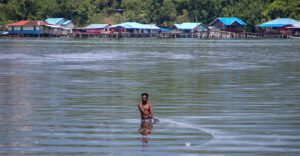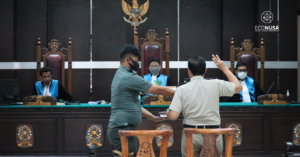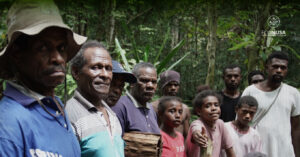
Sarmi Regency is planned to become one of the central cocoa-producing regions in Papua. In 2016, the Papua Development Acceleration Agency designated the regency as a hub for chocolate commodities. However, the community-based cocoa farming sector has not developed well. Many of the community’s cocoa farms have been infested with pests and subsequently abandoned.
EcoNusa Foundation, in collaboration with Intsia Papua Foundation, held a Post-Harvest and Farm Rehabilitation Training in Konderjan Village, Tor Atas District, Sarmi Regency. The event, held from March 18–21, 2025, was attended by 46 participants. They learned cocoa cultivation techniques, including how to combat pests using materials readily available in their surroundings.
Also Read: The Story of Cacao Farmers in Papua: from being Successful to Now being Struggle
In his opening remarks, Konderjan Village Head, Aser M. Borom, said that community cocoa farms had long suffered from cocoa pod borer infestations, and people had been unable to control them. The community had asked the government for help several times but had not yet received the needed assistance.
The village head expressed hope that through this training, villagers would truly learn and apply the knowledge shared by the facilitators, such as how to keep the farms clean and productive. He also encouraged group leaders and village officials to actively support the sustainability of this program so that Konderjan Village could become a model village for cocoa cultivation. “Konderjan Village was once known as the king of chocolate. I hope this program can bring back the glory of cocoa,” he said.
Also Read: Keerom Regent: Keerom Regency Progressing, if Village Moving Ahead
On the first day of training, Andi Wamafma from Intsia and facilitator Benny Ramandey began by exploring the community’s current farming practices—from land clearing, seed introduction, seedling preparation, pruning, harvesting, to post-harvest processing. According to Andi, the community had already been practicing cocoa care, but several elements needed improvement to ensure a better yield, especially in handling pests. “I believe that you already hold a lot of knowledge—we just need to build on it,” Andi said.
On the following day, participants were taken to the fields for hands-on practice. Activities included clearing plants that hinder cocoa tree growth before planting, selecting quality fruits for seeds, and practicing bud grafting. “Side grafting is usually done for older cocoa trees. We graft so that the old tree can produce healthy new growth and better fruit,” he explained.







